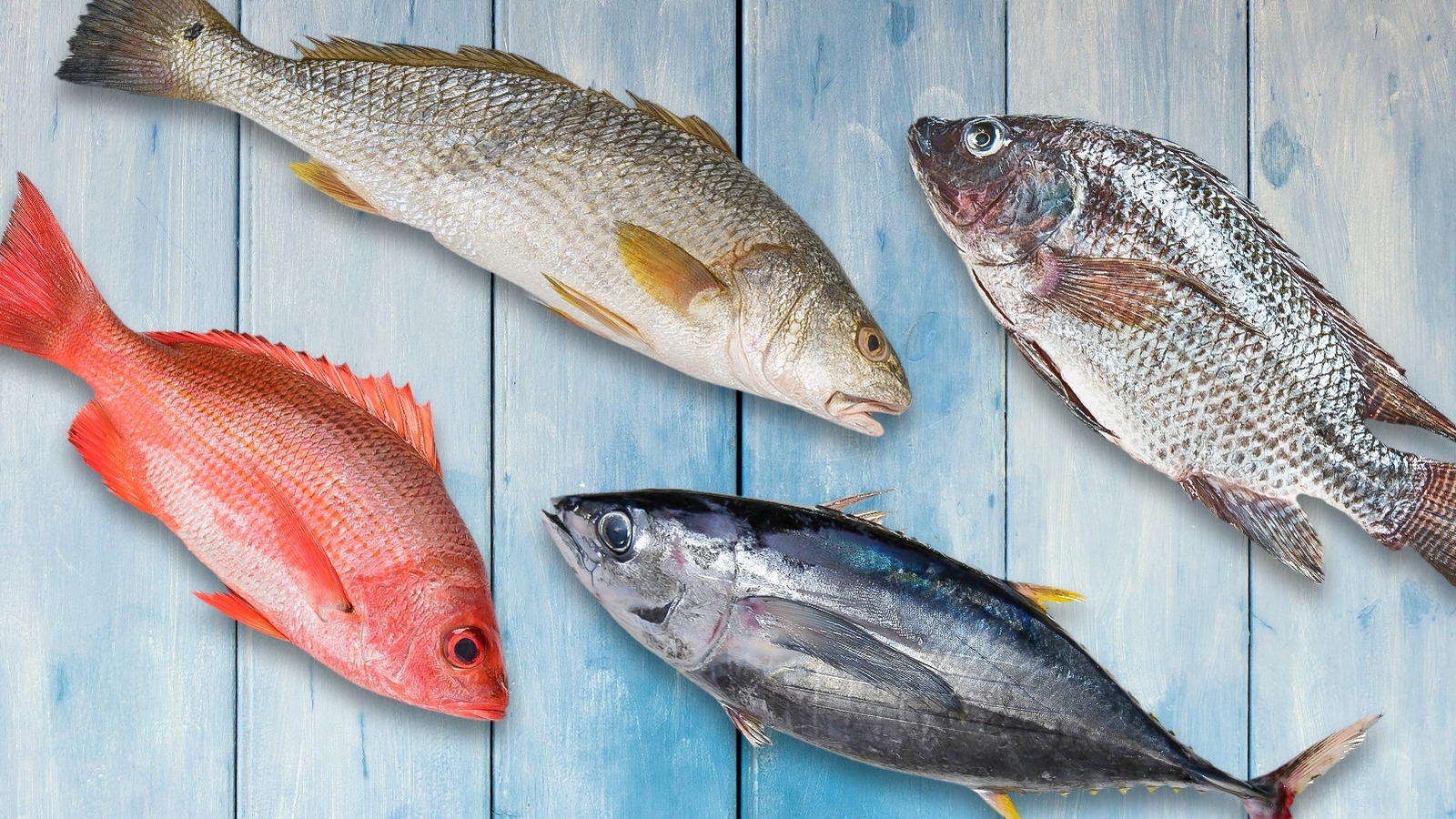A number of fish species are marketed as luxuries, and certain types boast premium prices on restaurant menus and seafood markets. However, a high price does not equate to greater quality, taste, or nutrient value. Many of the more expensive fish are overpriced because they’re in short supply, are exported across the world, or demand complicated farming and harvesting processes. Alternatively, some consumers are drawn to pricey seafood because of its perceived health benefits or elusive taste.
In an effort to better understand which fish aren’t worth the extra expense, we spoke with Kristin Donovan, co-founder of Hooked Inc. in Toronto — a well-respected seafood market known for sustainable acquisition and industry expertise. With years of experience in the seafood industry, Donovan offers insight on what to look out for and why.
From species whose quality varies daily to those mishandled in kitchen after kitchen, the list of high-priced ocean and sea critters that aren’t worth the splurge is more surprising than consumers realize. By breaking down why these fish cost so much — and if they’re even worth it — we’ll help you figure out what choices are worth your dollar.
Some types of salmon
Salmon is one of the most popular fish choices in the world, but not all salmon is worth the cost. Some types — especially organic and wild salmon — are frequently made pricey due to public demand outpacing availability. “Certain wild salmons are expensive, in high demand, and in low supply. This makes it overpriced for the average consumer,” Donovan explains. While salmon is famous for being very high in omega-3 and its health benefits, consumers are actually overpaying for some labels like “organic” or “king salmon” when they don’t consider that there are lower-priced options available.
Consumers, in most cases, are drawn to these varieties due to their perceived health benefits, but the reality is that other salmon varieties and even other fish varieties carry the same nutritional value without the premium price tag. This assumption has led to marketing and trends across the continent that have guided prices just as much as quality. Donovan notes that many consumers stick to salmon out of habit: “We hear all the time that we should eat fish once a week, and salmon especially is one everyone lands on. You can actually experiment two or three times a week with a bunch of options and figure out what you like.”
So, although salmon is a healthy option, the expensive price point isn’t always warranted. Health-conscious consumers can do themselves a favor by trying other types of fish that are equally nutritious without breaking the bank.
Swordfish
Swordfish is often treated as an upscale seafood choice. You’ve likely heard that its firm, meaty texture makes it an excellent substitute for a steak. But it’s important to note that its premium price isn’t necessarily indicative of a premium product. The biggest issue with swordfish is that it’s overcooked so frequently, with countless recipes warning of dryness from overcooking in their step-by-step instructions. This yields a dehydrated, tough texture — not the rich, buttery bite that consumers want.
It doesn’t end there. Swordfish has one of the highest mercury levels in any fish that’s commonly eaten, so it’s not a healthy choice for regular consumption. Since it’s expensive, this means that people are paying a premium for fish that’s accompanied by a host of health risks. Pregnant women and small children are usually discouraged from eating swordfish due to these high mercury levels. It’s an iffy purchase for many households, to say the least.
Closely following the aforementioned cons is its inconsistency. Unless procured from a decent supplier, the quality of swordfish isn’t guaranteed. Sometimes, certain cuts of the mythically shaped sea creature can be fresh and palatable, and on other occasions, tasteless, unpleasant, and mushy. Although others may prefer the delicate flavor and steak-like density, there are better alternatives out there that provide fewer health risks without the expensive price tag. With these considerations in mind, swordfish’s status as an upscale seafood option may not be justified. Unless it’s cooked well, bought from a quality source, never frozen, and served primarily to non-pregnant adults … the price tag may not be worth the gamble.
Tilapia
Tilapia is often credited for being an affordable, readily available fish, so it’s a controversial addition to this list. Ultimately, its shortcomings earn it the distinction of still being poor value despite its pricing. “Tilapia is probably the weirdest. It’s pretty basic. Little to no health benefits, farmed terribly everywhere — I can only think of a few operations where they’re farmed decently,” says Donovan. “Not particularly high in protein either compared to other fish. Not worth the price to me.”
Although it’s bland in flavor and easy to cook, tilapia lacks the high nutrient content of other fish. In contrast to fatty fish such as salmon or sardines, tilapia contains comparatively small levels of omega-3 fatty acids, which are essential for brain and heart health. Rather, tilapia contains a higher level of omega-6 fatty acids, which, in excess, may contribute to inflammation.
Tilapia rearing practices are also a cause of concern since it’s often reared in overpopulated conditions, leading to its lower quality and even potentially giving way to harmful chemical exposure. Farmed tilapia has, in some cases, been found to contain antibiotics and impurities from unclean water conditions. There’s definitely some responsibly raised tilapia out there, but the consumer may not always have the knowledge to distinguish the quality in their sources. While it’s still a staple in many households because of its relative inexpensiveness and commonality, the facts make it a less desirable option. For those willing to switch, however, there are other types of fish that are tastier and more nutritionally valuable at a similar price.
Bluefin tuna
Bluefin tuna is one of the most expensive fish in the world. Who hasn’t seen viral stories of the massive fish selling at Tokyo auction blocks for as high as millions of dollars? Although it’s a beloved sushi option for people who enjoy it because of its fresh and rich consistency, its expense is actually due to imposed scarcity and foreign demand rather than intrinsic value to the end consumer.
“A lot of the lobster or bluefin tuna we harvest goes straight to Asia because the demand is so massive compared to this region, which makes it pricier for the home market,” Donovan tells us. Bluefin is expensive for North American consumers because it’s a global luxury item, not so much because it’s better than other tuna.
Aside from the cost, bluefin tuna is also one of the most overfished species, which naturally introduces concerns regarding sustainability. Because strict regulations are in place to prevent overfishing, its supply ends up curtailed, thus keeping prices high. Bluefin tuna fishing imposes a significant environmental toll as industrial-scale fishing operations keep dwindling its numbers despite conservation efforts around the world. Since it’s so deeply prized on high-end sushi menus, the ethical and financial cost renders bluefin tuna a questionable treat for the average seafood lover. Many seafood experts and sushi chefs recommend trying other varieties of tuna that offer similar flavor without the exorbitant cost or environmental concerns.
Chilean sea bass
Chilean sea bass is a species of sea bass widely sold as an upscale seafood product, but when you dig a little deeper, the value is hard to justify. The name alone is somewhat deceiving since Chilean sea bass is not technically a bass, but instead a Patagonian toothfish. Although the delicate, umami taste this “bass” has a reputation for is heavily sought after, its price is inflated both by excess fishing and sky-high foreign demand.
Sustainability is a large concern with Chilean sea bass. Since it’s been overfished to a significant degree, strict controls from conservation efforts drive the price much higher. There are some sustainably certified fisheries, but, unsurprisingly, there aren’t many. Similarly to tilapia, it’s difficult for consumers to be sure whether they’re purchasing responsibly caught fish. Additionally, the taste and texture of Chilean sea bass, while enjoyable, isn’t necessarily superior to those of other, less costly white fish species. Even when it’s labeled as a luxury dish, the fish’s price doesn’t necessarily translate to a better culinary experience. Coupled with the aforementioned issues and inflated value, it may not be the best choice for quality-conscious seafood lovers seeking out good quality and good value, no matter the price.
Halibut
Maybe the biggest issue with halibut is that, not unlike swordfish, it is a very easy fish to overcook, making for a dry, unpleasant meal just after spending the cash. “I tend to go to the best spots in the city, but halibut is a miss for most,” says Donovan. “A lot of people overcook it and don’t know what good halibut is supposed to taste like.”
Relative to some other high-end fish, halibut doesn’t boast a naturally occurring high fat level. So if it’s not cooked carefully, it becomes dehydrated and fibrous at a rapid pace. This renders the fish rather tricky to the home cook, as well as professional cooks. The skill required to nail the doneness of the species contributes to the value of halibut as a riskier purchase for individuals who want to have the same tender, delicious meal every single time.
Lastly, halibut is not as nutrient-dense as other fattier fish like salmon or mackerel. While it’s a good source of lean protein, it lacks the nutrient-rich omega-3 levels contained in some overpriced fish that make them more worth the splurge. At the price consumers are paying, maybe halibut isn’t such a fantastic deal, especially if they’re not dining at a restaurant that’s skilled at handling this very temperamental fish.
Black cod
Black cod or sablefish is typically sold at a premium price, however, the price tag is not particularly reflective of its value. According to Donovan, “When it comes to 1/100 or 1/200 of the [black cod we process] they actually melt as soon as they hit the heat out of the water. I think it has something to do with the pressure in which they travel.”
The inconsistency of black cod, especially in terms of texture, makes it a bit of a gamble to buy. The fragile fillets tend to break apart depending on the external environment, especially when exposed to improper processing techniques. This result is common enough for Donovan to have her fishmongers take extra precautions. “We trim the ends off to ensure that they hadn’t broken apart prior to selling,” she explains, highlighting the efforts involved in ensuring stock of high-quality black cod.
These unpredictable texture issues, coupled with its priciness, make black cod a choice that consumers would probably want to consider carefully. Donovan offers the meticulous buyer some alternatives: “Silver bass, white perch, [and] other lake fish are very affordable and taste great. I’d take those over sea bass. Rockfish, lingcod are also great options.”
Red snapper
Red snapper is often placed on restaurant menus and marketed as a healthy, tasty option. Yet, even though red snapper is a more premium fish, it can fall short in terms of taste and memorability. Donovan comments, “A lot of people just buy red snapper, king salmon, or organic salmon because it sounds healthy and the name is familiar, which is a shame because once you get into good fish, there are so many options out there … I think people should be eating a lot more shellfish; oysters, clams, and crayfish. They’re great and versatile.”
Though red snapper has a touch of sweetness and mildness to its flavor, it becomes lost among bolder types of fish and leaves people scratching their heads over why it costs so much. Furthermore, snapper is sometimes raised under questionable circumstances, both impacting its quality and sustainability. While snapper is marketed as a high-end product, it doesn’t necessarily guarantee any superiority over lower-cost varieties.
The price for red snapper, particularly from the United States and other countries in the Western world, has increased as a result of its demand. The demand for the snapper is not always due to the quality of the fish. While it finds its place on fine dining tables, you can undoubtedly find something more flavorful at a lower cost.
Dover sole
Dover sole is known to be a sophisticated and refined seafood option, gracing the menus of upscale restaurants across the country. Its texture and flavor make it an ideal choice for those who want a light, refined fish. Nevertheless, despite its reputation, Dover sole is sometimes overpriced. Many hold the unfounded perception that the more expensive the species, the better the flavor. But when a fish is mild or neutral in taste, the price does not always translate into a better meal.
Another drawback of Dover sole is that it can be overcooked. Sole’s soft, flaky texture can dry out and fall apart if not treated gently. So, similar to halibut and black cod, it’s a riskier choice for home cooking. The cost is also partly because it’s harvested in a particular manner — typically wild-caught, which may contribute to scarcity and further drive up the price. For those who want a rich and full-bodied seafood experience, Dover sole’s subtle taste may not hit the spot without a little buyer’s remorse. Although it has fans, the cost usually outweighs its worth as a meal.
Orange roughy
Orange roughy experienced a rebirth in branding and appeal in the 1970s, becoming a staple in households for its flakiness and inexplicable popularity after some good PR (it used to be named “slimehead”). However, its price is not always worth its value. The largest issue with orange roughy is its unsustainable harvesting methods following its endangered status in the ’70s. This deep-sea fish grows slowly and reproduces late, so its populations are highly vulnerable to overfishing. Harvesting methods like bottom trawling raise concerns about the ethics of the practice and its propensity for significant environmental damage.
While orange roughy can be considered a splurge-worthy fish for its taste and texture, its overfishing issues and endangered history make it a poor choice for environmentally conscious consumers. Overfishing has resulted in severely depleted stocks in some areas, and some fisheries have outright lost their sustainability certifications over it. This has assisted in developing the image of orange roughy as an elusive, high-end product. In reality, it’s habitual overfishing that birthed its scarcity.
With the increased consciousness regarding the need for sustainability and ethical seafood choices, the premium price of orange roughy is something that’s become increasingly difficult to ignore. There are just too many other fish that would offer comparable tastes and textures, sans the environmental cost to the planet.





